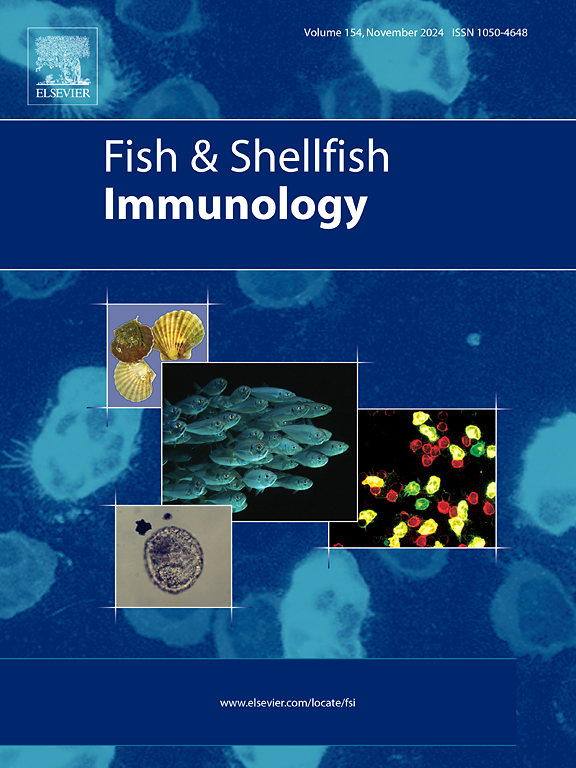大肚海马肠道微生物群在Edwardsiella piscicida诱导的致死性肠炎中的相互作用:对碳水化合物活性酶的作用和宿主转录反应的新见解。
IF 4.1
2区 农林科学
Q1 FISHERIES
引用次数: 0
摘要
爱德华氏菌(Edwardsiella piscicida)诱发的致死性肠炎是海马养殖业可持续发展的主要威胁。人们对碳水化合物活性酶(CAZymes)在病原体与宿主相互作用中的作用知之甚少。在这项研究中,我们发现鱼腥藻编码的 22 种关键 CAZymes 可能参与协调感染的五个关键阶段。具体来说,在运动、粘附和入侵阶段,包括CE4、PL8和CBM48在内的10种CAZymes可能会显著增加肠道微生物群脂质代谢相关途径的活性(P < 0.01),从而促进病原体入侵宿主肠道上皮细胞。在复制阶段,GH20、GT4 和 GH3 等 11 种 CAZymes 可显著提高碳水化合物代谢相关途径的活性(P < 0.01),促进病原体的复制和增殖。而为了躲避宿主的防御,GH2 和 GH1 可能会提高碳水化合物和氨基酸代谢途径的活性(P < 0.01),从而促进感染和免疫逃避。联合分析表明,鱼腥藻可能主要依赖碳水化合物代谢途径进行感染,而宿主可能激活氨基酸代谢途径进行自卫。此外,Aldh9a1b、Aoc1、Tpi1b、PCK1、Ldha、Me1、Gla、Cel.2、Ugdh 和 Mao 等 10 个关键基因的表达发生了显著变化(P < 0.01),可用于描述宿主对鱼腥藻感染的反应。发现病原体和宿主之间的糖酵解/葡萄糖生成和色氨酸代谢活动分别发生了相反的变化(P < 0.01),这代表了竞争的主要焦点。总之,本研究首次从CAZymes的角度对E. piscicida介导的鱼类肠炎有了新的认识,并为海马及其他鱼类养殖过程中此类疾病的防控提供了理论参考。本文章由计算机程序翻译,如有差异,请以英文原文为准。
Host-intestinal microbiota interactions in Edwardsiella piscicida-induced lethal enteritis in big-belly seahorses: Novel insights into the role of Carbohydrate-Active enzymes and host transcriptional responses
Edwardsiella piscicida-induced lethal enteritis is a major threat to the sustainable development of seahorse aquaculture. The roles of Carbohydrate-Active enzymes (CAZymes) in interactions between the pathogen and the host are poorly understood. In this study, we found that 22 key CAZymes encoded by E. piscicida might involve in the coordination of five key stages of infection. Specifically, during the motility, adherence, and invasion stages, 10 CAZymes, including CE4, PL8, and CBM48, may significantly increase the activities of Lipid metabolism-associated pathways of the intestinal microbiota (P < 0.01), facilitating pathogen invasion of the host intestinal epithelium. During the replication stage, 11 CAZymes, including GH20, GT4, and GH3, may significantly increase activities of pathways associated with Carbohydrate metabolism (P < 0.01) to promote replication and proliferation of the pathogen. And for avoiding host defenses, GH2 and GH1 may enhance activities of both Carbohydrate and Amino acid metabolic pathways (P < 0.01), facilitating infection and immune evasion. Conjoint analysis showed that E. piscicida might mainly rely on Carbohydrate metabolism for infection, while the host might activate Amino acid metabolic pathways for self-defense. In addition, expressions of 10 key genes, Aldh9a1b, Aoc1, Tpi1b, PCK1, Ldha, Me1, Gla, Cel.2, Ugdh, and Mao, were significantly altered (P < 0.01) and may be used for characterizing host responses to E. piscicida infection. Activities of both Glycolysis/Gluconeogenesis and Tryptophan metabolism were found oppositely changed (P < 0.01) between pathogen and host, respectively, representing the primary focuses of the competition. Overall, this study provides new insights into E. piscicida-mediated intestinal enteritis in fish for the first time from the perspective of CAZymes, as well as a theoretical reference for the prevention and control of these diseases in the aquaculture of seahorses and other fish.
求助全文
通过发布文献求助,成功后即可免费获取论文全文。
去求助
来源期刊

Fish & shellfish immunology
农林科学-海洋与淡水生物学
CiteScore
7.50
自引率
19.10%
发文量
750
审稿时长
68 days
期刊介绍:
Fish and Shellfish Immunology rapidly publishes high-quality, peer-refereed contributions in the expanding fields of fish and shellfish immunology. It presents studies on the basic mechanisms of both the specific and non-specific defense systems, the cells, tissues, and humoral factors involved, their dependence on environmental and intrinsic factors, response to pathogens, response to vaccination, and applied studies on the development of specific vaccines for use in the aquaculture industry.
 求助内容:
求助内容: 应助结果提醒方式:
应助结果提醒方式:


